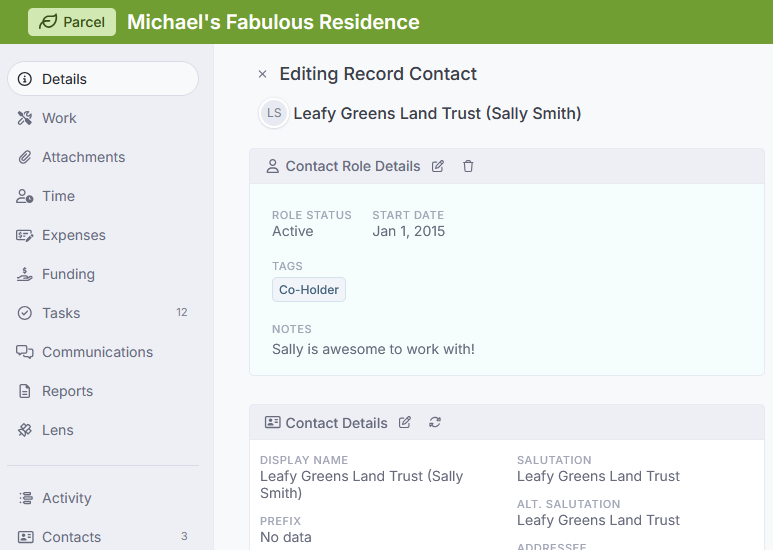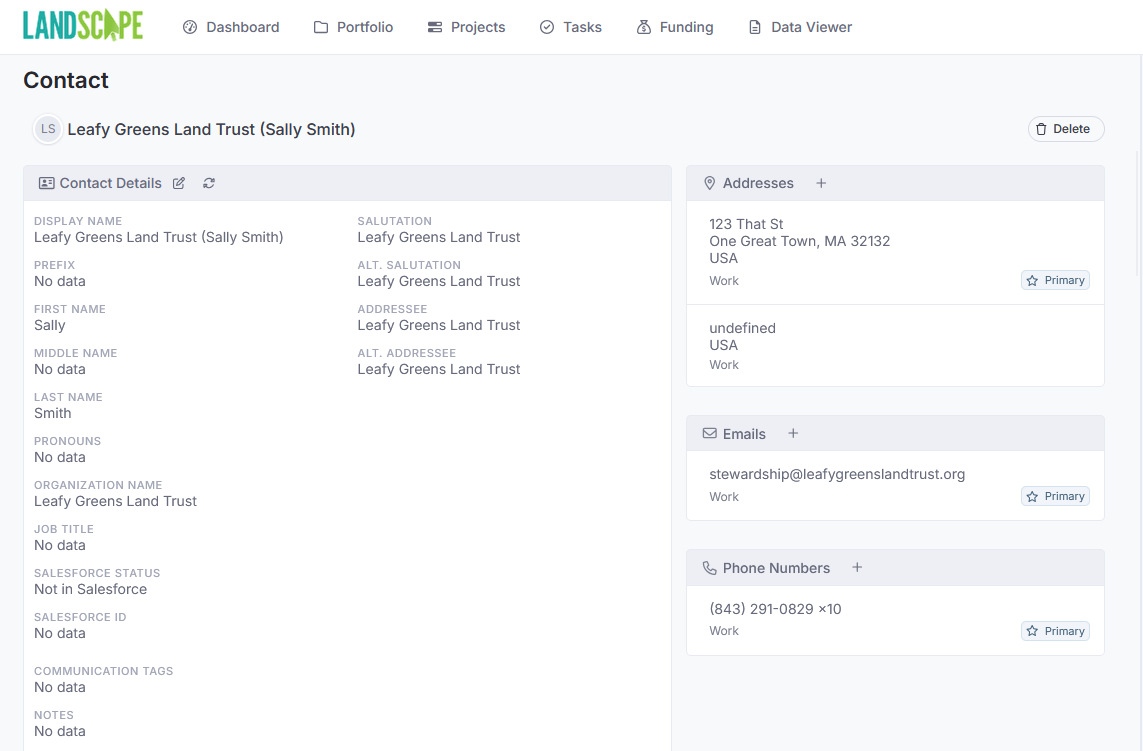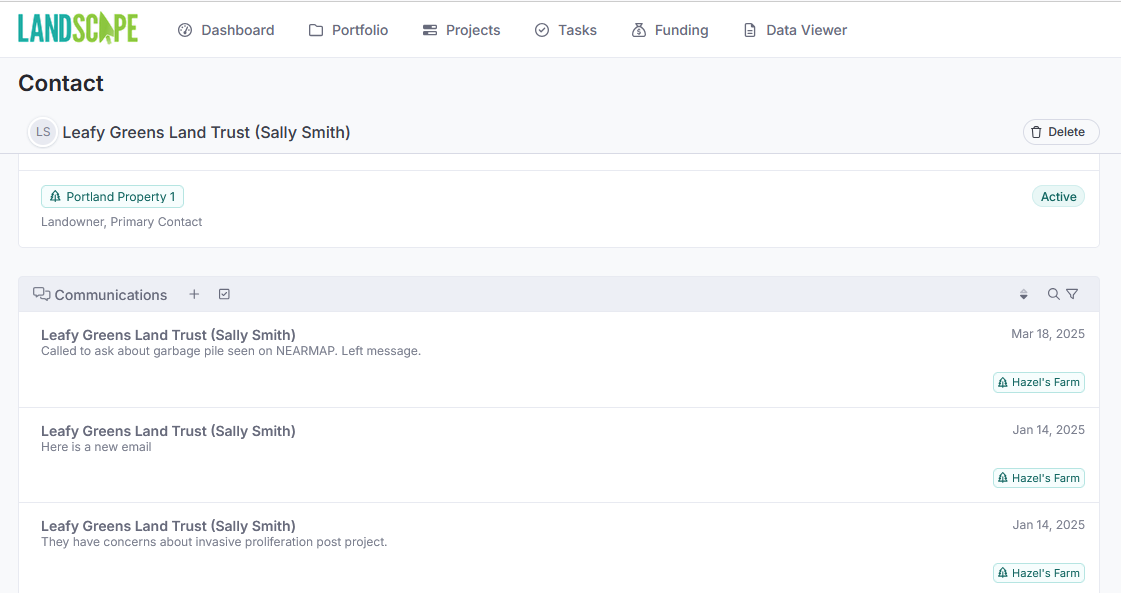Contact Fields
Here is a breakdown of the various fields that you can track within a contact record, as well as how to deal with some common scenarios when it comes to contact data. If you're curious about how contacts and their relationship to Properties are tracked in Landscape, check out this article.
Record Contact Fields
These fields describe the relationship between the contact and the record. For example, they tell you that the contact 'Larry Smith' is the 'Landowner' and the 'Grantor' of the Property record you're looking at. They can only be seen if you navigate to a contact record from a Portfolio Record page.
Tags Allow you to tag the contact with one or multiple custom tags. Tags can be created in Settings > List Items > Portfolio > Contact Tags. You must be an administrator to access settings. Common tags include 'Landowner'; 'Grantor'; 'Monitoring Contact'; 'Co-holder'; 'Neighbor'.
Start Date Is when the person's relationship with the record began. Like when they bought the property.
End Date Is when their relationship with the record ended, like when they sold the property. Any record contact with an end date will become 'inactive' and moved to the bottom of the contacts list for that record.
Record Relationship Notes is a place to enter notes about the individual or organization's relationship with the property. Examples might include 'Inherited property from parents. Absentee landowner'. It can also be an excellent place to store the ID number that a co-holder or partner organization uses for the Property in question.

Contact Details
These fields belong to the contact record itself. Edits made to these fields will affect the contact record in any other record it's associated with. For example, if you change the name of 'Leafy Greens Land Trust' to 'Leafy Greens Land Trust (Sally Smith)', it will be updated in all locations where Leafy Greens Land Trust is listed as a contact.
Display Name is the full name of the individual, individuals, or organization. This is the only field which is searchable with the search bar. Here's what we recommend as the display name format for the following types of contacts so that you make the most of this ability:
- Individuals: '[First Name] [Last Name]' eg. 'John Doe'
- Couples: '[First Name 1] and [First Name 2] [Last Name]' or '[First Name 1] [Last Name 1] and [First Name 2] [Last Name 2]'. eg. 'John and Jane Doe' or 'John Doe and Jane Smith'
- Companies or Organizations: '[Name of Company] ([Contact First Name] [Contact Last Name])' e.g. 'Leafy Greens Land Trust (Sally Smith)'
First is for the first name. For organizations or companies, you may want to enter the first name of your primary contact at that organization.
Middle is for the middle name.
Last is for the last name. For organizations this can be left blank
Pronouns can be used to note how the individual prefers to be addressed (He/Him, She/Her, They/Them, etc.)
Title is for the title/role of the individual. 'Vice President of Marketing' (Mr./Mrs./Dr. belongs in Salutation)
Contact Notes are for notes on the contact, but not about the relationship between the contact and the property. For example, 'Don't mention the Eagles (band or sports team)'.
Communication Tags are for specifying preferred methods of contact like 'Do not Call'. You can specify additional communication tags in Settings > List Items > Communications. You must be an admin to access settings.
External ID is a customizable ID field. If you are maintaining a separate (non-integrated) contact list, for example in a CRM platform like DonorPerfect, you may wish to make the ID numbers from that system match the ID numbers in Landscape. You can then export the contact list from Landscape and compare it/import it into another system based on this number. If this is not a need for you, this number can be ignored
Little Green Light fields
If your account is integrated with Little Green Light, then you will have access to Little Green Light ID, which is where you specify the contact record ID from Little Green Light. You will also have Synchronize which tells Landscape whether or not to synchronize the contact record with LGL.
AUTOFILL THESE FIELDS will autofill the fields below with information from the previous fields. You can also of course manually fill them out.
Salutation is what you would say after 'Hi' or 'Dear'. Such as 'Hi Bob' or 'Dear Mr. Smith'
Alternate Salutation can be used for noting an alternate to the above, like a more formal option.
Addressee is what is written on the top line of an envelope above the address. This field accepts multiple lines, e.g.
Bob Franklinburg
c/o Pretty Good Appraisals, Inc.
Alternate Addressee is a space for an alternate to the above option.
Addresses
Phone Numbers
Emails

Linked Records
This area shows a list of all Portfolio Records that the contact has been added to. For example, if the same organization is tagged as 'co-holder' in multiple records, it will show you a list of all records that that co-holder is associated with.
This automatic list can be a useful way of navigating to a record if you can't remember the name of the record but can remember the name of the landowner. Search for the landowner's name, navigate to the contact record, then select the correct property from the associated records list.
Communications
Is where you can enter and see all communications with the contact, regardless of which record it was entered in. If you are entering a communication about a particular property, it is recommended that you enter that communication from the 'Communications' tab of that property.

Little Green Light Categories
If your account is synchronized with Little Green Light, you will have some additional categories below the 'Communications' records. These fields are Acknowledgement Preference; Communication Tags; Giving Status (uneditable); Groups; and Landscape Status
These fields, along with any of the fields listed above, will synchronize with Little Green Light if changed in Landscape. Changes in Little Green Light will also be reflected in Landscape.
